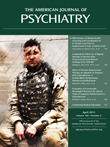Lithium-Associated Hyperthyroidism Treated With Lithium Withdrawal: A Case Report
To the Editor: Lithium, a first-line treatment for bipolar disorder, is a well-known cause of hypothyroidism; however, case reports have documented the emergence of thyrotoxicosis during lithium treatment, with evidence showing the incidence rate to be greater than expected in the general population (1–3). The recommended conservative management is antithyroid medication and continuation of lithium (4). It is advised that lithium not be withdrawn because of several reports of exacerbation of thyrotoxicosis (1, 2, 5). We report the case of a patient with lithium-associated hyperthyroidism treated with drug withdrawal, a treatment method documented in only one previous case (6).
“Mr. A,” a 61-year-old man with bipolar disorder, had been treated with lithium and haloperidol for 7 years. His thyroid function test results were normal in January 2009. Routine testing in August 2010 revealed a low therapeutic lithium level (0.50 mmol/L [normal range=0.50–1.50]) and a low thyroid-stimulating hormone (TSH) level (0.02 mU/L [0.34–5.60]). A thyroid function panel drawn 5 days later revealed low TSH (0.03 mU/L), elevated free thyroxine (1.73 ng/dL [0.58–1.64]), and elevated free triiodothyronine (4.8 pg/mL [2.4–4.2]). Results of tests for thyroid antibodies were negative. The patient was asymptomatic, and findings on a physical examination were normal. A thyroid uptake scan showed a 24-hour 131I uptake of 3.8% (normal range=7–33), normal gland size, and heterogeneous tracer activity, consistent with thyroiditis. Because of the thyroid dysfunction as well as borderline renal function (creatinine 1.3 mg/dL [0.5–1.3]), lithium was tapered off (from 600 mg/day to 300 mg/day for 7 days and then off). The patient was maintained on haloperidol monotherapy, which was titrated up. Four weeks later, the patient's free thyroxine level had normalized (0.87 ng/dL).
Theories that lithium causes hyperthyroidism include induction of autoimmunity and direct toxic effect causing thyroid hormone release (4). Notably, the three reports of exacerbation of thyrotoxicosis after withdrawal of lithium were in patients with Graves' disease. Conversely, our patient, who presented with thyroiditis, improved after withdrawal of lithium, which is consistent with the theory of lithium's direct toxic effect on thyrocytes. One could conclude that management of lithium-associated hyperthyroidism would differ based on the etiology of the thyroid overactivity. Our case suggests that patients who present with thyroiditis can be effectively treated with withdrawal of lithium.
1. : Graves' disease manifesting after maintenance lithium. J Nerv Ment Dis 1979; 167:575–577Crossref, Medline, Google Scholar
2. : Thyrotoxicosis and lithium. Br J Psychiatry 1976; 128:61–66Crossref, Medline, Google Scholar
3. : Association between lithium use and thyrotoxicosis caused by silent thyroiditis. Clin Endocrinol 2001; 55:501–508Crossref, Medline, Google Scholar
4. : Iatrogenic thyrotoxicosis: causal circumstances, pathophysiology, and principles of treatment: review of the literature. World J Surg 2000; 24:1377–1385Crossref, Medline, Google Scholar
5. : Asymptomatic Graves' disease during lithium therapy. Postgrad Med J 1978; 62:295–296Crossref, Google Scholar
6. : Exophthalmos and elevated thyroxine levels in association with lithium therapy. J Clin Psychiatry 1981; 48:398–400Google Scholar



